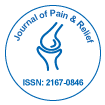开放获取期刊获得更多读者和引用
700 种期刊 和 15,000,000 名读者 每份期刊 获得 25,000 多名读者
索引于
- 哥白尼索引
- 谷歌学术
- 打开 J 门
- Genamics 期刊搜索
- 宇宙IF
- 参考搜索
- 哈姆达大学
- 亚利桑那州EBSCO
- OCLC-世界猫
- 普布隆斯
- 日内瓦医学教育与研究基金会
- 欧洲酒吧
- ICMJE
有用的链接
开放获取期刊
分享此页面
抽象的
Subjects with Knee Osteoarthritis Exhibit Widespread Hyperalgesia to Pressure and Cold
Penny Moss*, Emma Knight and Anthony Wright
Hyperalgesia to mechanical and thermal stimuli are characteristics of a range of disorders such as tennis elbow, whiplash and fibromyalgia. This study evaluated the presence of mechanical and thermal hyperalgesia in individuals with knee osteoarthritis (OA), compared to healthy control subjects. Twenty-three subjects with knee OA and 23 healthy controls, matched for age, gender and BMI, were recruited for the study. Volunteers with any additional chronic pain conditions were excluded. Pain thresholds to pressure (PPT), cold (CPT) and heat (HPT) were tested at the knee, ipsilateral heel and elbow, in randomized order, using standardised methodology. Significant between-groups differences for PPT and CPT were found: OA subjects demonstrated significantly increased sensitivity to both pressure (p=0.018) and cold (p=0.003), but not to heat (p=0.167) stimuli, compared with controls. A similar pattern of results extended to the pain-free ipsilateral ankle and elbow indicating widespread pressure and cold hyperalgesia. This study found widespread elevated pain thresholds in subjects with painful knee OA, suggesting that altered nociceptive system processing may play a role in ongoing arthritic pain for some patients.

 English
English  Spanish
Spanish  Russian
Russian  German
German  French
French  Japanese
Japanese  Portuguese
Portuguese  Hindi
Hindi